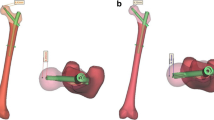Abstract
The purpose of this experimental examination was to determine the load-bearing capacity (LBC) of different inter- and subtrochanteric fractures under alternating physiological and static loads. These fractures are typical injuries of the geriatric patient, and full LBC restoration is needed for mobilisation. From patients over 60 years old at the time of death, 301 femora were obtained and randomly allocated to the following osteotomy (OT) groups: A1, flat and steep OT; A2, OT with 2/3 and complete medial cortical defect; reversed inter-(A3) and subtrochanteric OT; subtrochanteric resection and double plate compound osteosynthesis (DPCO); and the control group (no OT). Following osteosynthesis various devices were tested: condylar plate, 130° angle nail plate, 145° angle nail plate, double T profile angle nail plate, 135° DHS, 150° DHS after valgisating displacement OT, Ender nails, gamma nail and Orthofix external fixator. The femora were tested under alternating physiological load and under static load. The load-bearing capacity (LBC) was 5141 ± 1621 N in flat A1 OT, 4501 ± 1621 N in steep A1 OT and 3767 ± 1500 N in A2 OT with partial defect. In reversed intertrochanteric OT the LBC was 3770 ± 1798 N and in the reversed subtrochanteric OT, 5308 ± 2330 N. In A2 OT with complete medial defect, only the gamma 2nail (5672 ± 726 N) and the DHS after valgisating displacement OT (7261 ± 1794 N) showed a high LBC and no alternating load instability. After subtrochanteric resection and DPCO (7415 ± 1840 N) the LBC was the same as that of the control femora (7271 ± 1941 N). The influence of the type of OT on the LBC and instability under alternating physiological load is also dependent on the implant characteristics. Only gamma nail osteosynthesis shows a high LBC in all types of OT, so it can be recommended as a single device for all inter- and subtrochanteric fractures of the elderly. In pathological subtrochanteric fractures involving metastases resection, the DPCO should be used because of the very high LBC. When the gamma nail is not used, only with a differentiated therapy regimen for the various types of inter- and subtrochanteric OT can a physiological LBC restoration be obtained.
Similar content being viewed by others
References
Amtmann E, Kummer B (1968) Die Beanspruchung des menschlichen Hüftgelenkes. Anat 127:286–314
Andrew TA, Thorogodd M (1984) Subtrochanteric fracture after Garden screw fixation: a review of predisposing factors and management in 9 cases. Injury 16:169–177
Chao EYS, Kasman RA (1984) The mechanical performance of the Orthofix axial external fixator. Recent Adv Traumatol, Symposium Venedig, Verhandlungsband
Friedl W (1992) Double plate compound osteosynthesis — a method of primary care with high loading capacity in problematic lesions of the subtrochanteric to supracondylar femoral areas. Aktuel Traumatol 22:189–196
Friedl W, Krebs H (1990) The significance of individual patient characteristics for loading capacity and deformation of the proximal end of the femur. Unfallchirurg 93:364–371
Friedl W, Ruf W (1987) The significance of individual characteristics for the loading capacity of per- and subtrochanteric osteotomies. An experimental study. 73rd Clinical Congress of the American College of Surgeons 11–16.10.1987, San Francisco. Surg Forum XXVIII: 534–536
Friedl W, Ruf W (1987) Experimentelle Untersuchungen zur Wirksamkeit des Gleitprinzips der dynamischen Hüftschraubenosteosynthese und ihrer Wertigkeit bei der Versorgung instabiler petrochanterer Femurfrakturen. Chirurg 58:106–112
Howard CB, Davies RM (1982) Subtrochanteric fractures after Garden screw fixation of subcapital fractures. J Bone Joint Surg [Br] 64:565–567
Kreusch-Brinker R, Jensen H, Rohlmann A (1992) Vergleichende biomechanische Untersuchungen zur Dauerschwingfestigkeit trochanterer Femurosteosynthesen. In: Berentey G (ed) Osteosynthese International. Aesculart, Budapest, pp 392–393
10.Martinek H, Wielke B, Egkher E, Fasol P, Passl R, Sauer G, Spängler H (1976) Die Belastbarkeitsgrenze verschiedener Osteosynthesen pertrochanterer Oberschenkelfrakturen. Arch Orthop Trauma Surg 84:273–284
Matter P (1984) Osteosynthesen der pertrochanteren Femurfrakturen mit Winkelplatten und dynamischer Hüftschraube. Hely Chir Acta 50:605–609
Müller ME (1991) Classification of bone fractures. Springer, Berlin Heidelberg New York
Pauwels F (1973) Atlas zur Biomechanck der gesunden und kranken Hüfte. Springer, Berlin Heidelberg New York
Rohlmann A, Mossnar U, Bergmann G, Kolbel R (1982) Finite elemente analysis and experimental investigation of stress in a femur. J Biomed Eng 4:241–246
Rössler H, Hamacher P (1972) Die biostatische Analyse der Belastung des Hüftgelenkes, part 1. Z Orthop 110:67–75
Rössler H, Hamacher P (1972) Die biostatische Analyse der Belastung des Hüftgelenks, part II. Z Orthop 110:186–196
Rybicky EF, Simonen A, Wels EB (1972) On the mathematical analysis of stress in the human femur. J Biomechanics 203–215
Rydell N (1965) Forces in the hip joint, part II. Intravital measurements. In: Kennedy RM (ed) Biomechanics and related bioengineering topics. Pergamon, Oxford, pp 351–367
Savvidis E, Löer F (1989) Magnitude of forces acting on the proximal femur in different relieving gaits with reduced ground reaction forces. Z Orthop 127:111–117
Scheuba G (1971) Zur Frage der Belastungsstabilität bei der Osteosynthese pertrochanterer Oberschenkelfrakturen. Acta Chir Austr 1:12–19
Schöttle H, Sauer HD, Adam O (1976) Die Nagel-Verbundosteosynthese bei instabilen pertrochanteren Frakturen. Unfallheilkunde 2:149–150
Author information
Authors and Affiliations
Rights and permissions
About this article
Cite this article
Friedl, W. Relevance of osteotomy and implant characteristics in inter- and subtrochanteric osteotomies. Arch Orthop Trauma Surg 113, 5–11 (1993). https://doi.org/10.1007/BF00440587
Received:
Issue Date:
DOI: https://doi.org/10.1007/BF00440587




